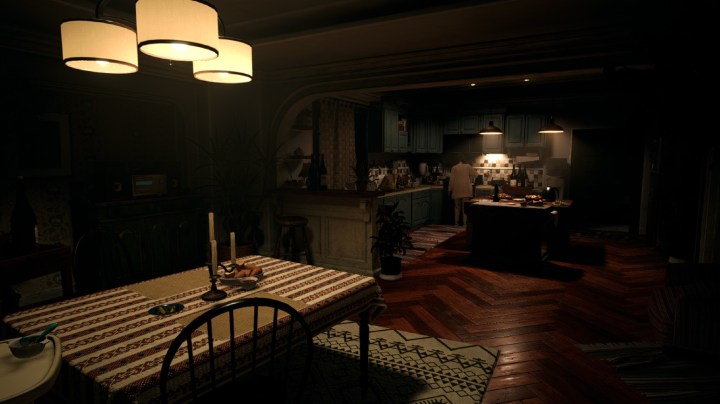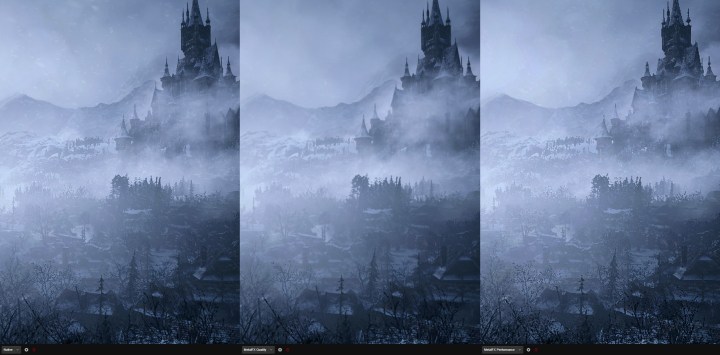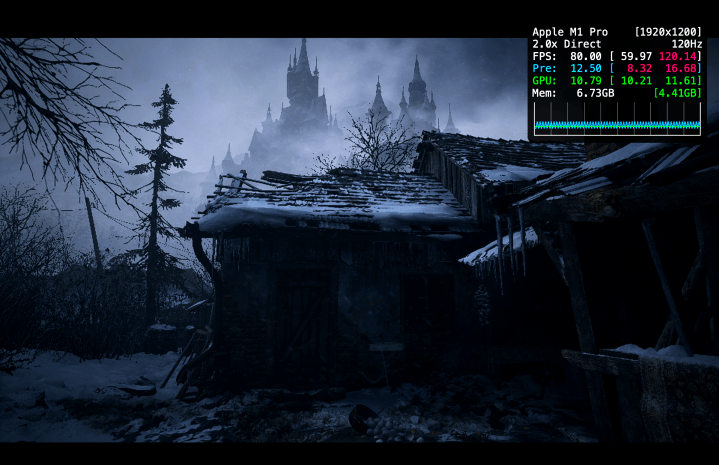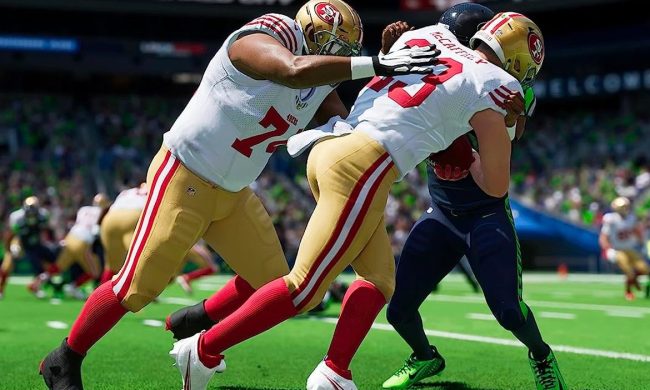Resident Evil Village launches in the Mac App Store today, and it’s been a long journey to get here.
Ever since the launch of the M1 Pro and M1 Max in the MacBook Pro last year, we’ve all been wondering if Mac gaming was about to make a true comeback. HDR screens, 120Hz screens, great GPU performance, and even Apple’s own MetalFX upscaling tech? It’s all the ingredients you’d need for a solid gaming experience. The only thing missing was games, and with Resident Evil Village, I finally got a taste of the future of Mac gaming.

Performance
I tested out Resident Evil Village on a 16-inch MacBook Pro with the M1 Pro and 32GB of RAM. For these specs, Apple recommended that I play in 1080p with the “Balanced” preset — so I started there. Of course, Apple told the world that playing Resident Evil Village on a MacBook Air was also possible, but I’ll get back to that later.
For now, I played through the game’s opening scenes, seeing how the hardware could handle the graphics. The M1 Pro handled it much like an entry-level gaming laptop. At 1080p Balanced, my MacBook averaged around 60 fps (frames per second) through much of the game. Resident Evil Village isn’t an overly demanding game, though the recommended GPU is a GTX 1070. Of course, frame rates will vary from scene to scene, and there were times when frame rates dipped under 60 fps. But hey, it’s quite close to the kind of RTX 3050 Ti-powered gaming laptop. That alone is pretty impressive as a comparison.
The real miracle is the way the MacBook Pro handles the heat. All throughout, the MacBook Pro stayed almost completely silent, its fans hardly spinning. The chassis did get warm, of course, but the keyboard and wrist rests stay comfortable. It’s in a different league compared to something like the Razer Blade 15. That’s standard for the MacBook Pro, but it’s incredible to see with a AAA game running on it.
Of course, there’s room for more with the MacBook Pro. It has a 120Hz refresh rate and a high-resolution screen, after all. And that’s where Apple’s MetalFX upscaling tech comes in — at least, in theory.
MetalFX upscaling

These days, the upscaling tech used by Nvidia, AMD, and even Intel is as important as the raw performance of the GPUs themselves. That’s even more true on laptops or lower-end PCs, from which you’re trying to get every extra frame possible. These upscaling features allow the MetalFX upscaling to be Apple’s own version of this, of course, and this is our first glimpse at seeing what it can do. You’ll find the setting right next to the graphics settings in the menu, and you’re given three options: Off, Quality, and Performance.

This is similar to what you get in other upscaling features, such as AMD FSR and Nvidia DLSS.
With MetalFX, though, the Performance setting results in a serious dip in quality. It appears to be even more noticeable in lower resolutions, which is unfortunate. You certainly can play like this, especially if you are on, say, a MacBook Air. In that case, it might be necessary. But in the case of playing on something like an M1 Pro, the performance trade-off of 10-15 fps doesn’t feel worth it. Textures and edges appear oversharpened to an unpleasant degree. It really spoils the entire vibe of the game, which relies so heavily on atmosphere to build tension and scares.
In the photo below, you’ll see odd textures across the roof of the snowy building, along with some very messy tree limbs right above it. It’s not a good look.

The Quality mode, though, is another story. It offers a more balanced approach to improving frame rates without too much of a drop in quality. Again, it adds another 10 to 15 fps, often scooting frame rates well over 60 fps for some much smoother gameplay that makes use of the higher refresh rate.
I’ll be honest. When it comes to the experience of the game itself with the M1 Pro, I found myself preferring the “Prioritize Performance” mode as opposed to using MetalFX. Objects in the distance tend to appear a bit smeared or blurred, not unlike early versions of FSR or DLSS. It’s not a bad place to start, but it’s not quite up to snuff with the later versions of either of those upscaling platforms.
HDR shines on the MacBook Pro

The most startling thing about playing Resident Evil Village on a MacBook Pro wasn’t actually performance. It was HDR. The MacBook Pro (16-inch) has one of Apple’s “XDR” displays, a mini-LED panel that’s better than any other gaming laptop display. That’s because mini-LEDs that can get this bright are still fairly uncommon in the world of gaming laptops. And in many ways, there’s no better game to play in HDR than Resident Evil Village.
Toggling HDR on and off changes the look of the game drastically. Shadows grow in corners of the room, light scatters in a different way, and it all adds to an even creepier sense of dread to the whole game. But with a thousand nits of peak brightness at this game’s disposal, the scenes really come to life. It’s hard to describe with words just how big of a difference true HDR makes, and because of the lack of available (and affordable) HDR PC monitors, too few of PC gamers have actually experienced it that way.
But clearly, Resident Evil Village in HDR is the ideal way to play the game, and strangely enough, the MacBook Pro might be the best laptop experience you can get with it.
More games please
Resident Evil Village is a great start for this new era of Mac gaming. It’s a fantastic showcase for the performance and display of the MacBook Pro. MetalFX Upscaling is off to a decent start, even if it’s not great just yet. The unique brilliance of the MacBook Pro (14-inch or 16-inch) hardware is what makes it all possible. From the quiet, cool chassis while playing to the speakers, it’s a gaming experience that can’t even be replicated on a dedicated gaming laptop. Strange as it sounds, it’s true.
Of course, this is only the beginning, and only time will tell how serious Apple really is about turning the Mac into a AAA gaming platform. Right now, the library of available titles is painfully small.
Still, Resident Evil Village has me excited about the prospect of more — and that’s not something I’ve been able to say about Mac gaming for many, many years.


